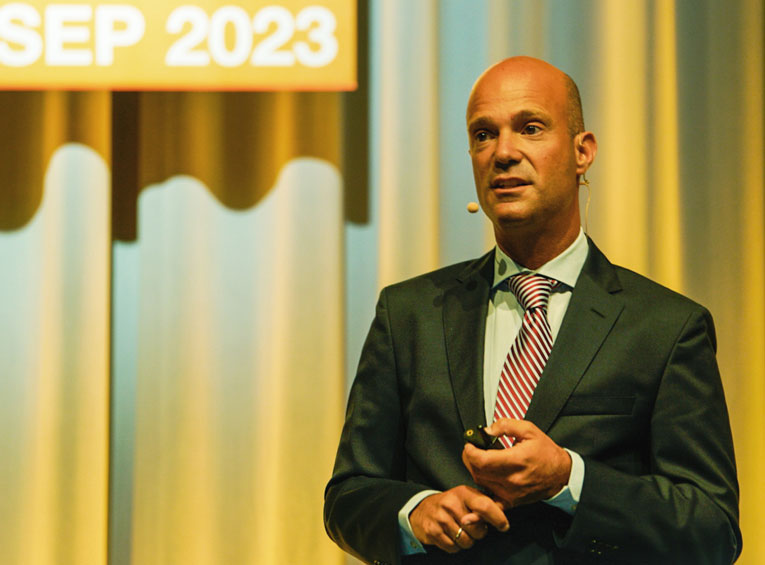This article is part of an extensive feature on the 2023 HAEi Regional Conference EMEA, published in Global Perspectives #2 2023
Taking the stage for the next to last presentation of the day, Dr. Danny Cohn remarked on the inspiring nature of the day and how overwhelming he had found the levels of engagement and advocacy from all the participants.
Introducing his talk, Dr. Cohn highlighted three reasons to search for new treatments: tolerability/safety issues, limited efficacy, and administration issues. Dr. Cohn made clear he understood that, for some, older treatments were all that was available. He had no wish to offend and explained these three points are the questions that drive improvement.
Recalling Prof. Maurer’s talk, Dr. Cohn showed that the latest guidelines indicate five first-line treatment options, with the ultimate goal being total control of the disease and normalization of the patient’s life. This means efficacy but also a lack of side effects and ease of administration. He outlined that people don’t want to be constantly reminded about their condition, so infrequent administration is attractive.
Dr. Cohn told the audience that he felt that, in a way, HAE is a fortunate patient population. Of course, he acknowledged that HAE is very serious. However, a great interest in the disease has led to new drugs. Part of this interest, he felt, was that results come quickly. You administer a drug and soon find out if it’s effective, as attacks won’t appear anymore.
Showing the targets for HAE treatment, such as Factor XII, kallikrein, bradykinin, and others, Dr. Cohn then outlined some of the new types of treatment being trialed to address these targets, which were: monoclonal antibodies, small molecules, oligonucleotide antisense (ASO) therapy, gene editing and gene therapy. These potential medicines come with different modes of administration and time between doses.
Dr. Cohn discussed two potential oral options (sebetralstat and deucrictibant) for acute therapy, as existing medicines are all injectable. These can be self-administered and may be more acceptable for children. Summing up current evidence on efficacy, Dr. Cohn made clear that when a patient first experiences the signs of an attack, these drugs should be effective very quickly.
Deucrictibant is also being evaluated as an oral prophylactic medicine, and two other experimental medicines called ATN-249 and KV998086. These were early in their development, said Dr. Cohn, but show the potential for more oral drugs for long-term prophylaxis.
Moving onto injectables for prophylaxis, garadacimab, donidalorsen, STAR-0215, NTLA-2002, and BMN-331 were highlighted.
Garadacimab is an inhibitor of Factor XII and a monthly injection. In trials, it led to an average reduction in monthly attacks of 87% compared to placebo. 62% of patients were completely free of HAE attacks.
Donidalorsen was described as a new way of targeting HAE, according to Dr. Cohn. It uses short strands of nucleotides to prevent the formation of a protein called prekallikrein, which is involved in angioedema attacks. Using the analogy of a recipe, Dr. Cohn said that donidalorsen acted to disrupt the chef’s recipe so less of the prekallikrein is produced in the liver. In a phase-II (safety and small-scale efficacy) trial, 90% of angioedema attacks were prevented, and a second dose led to a 97% reduction in attacks. The drug was well tolerated in trials, with the latest study hoping to report results in the coming months.
STAR-0215 is a long-acting version of the currently available medicine, lanadelumab. Hopefully, this will enable extended periods between injections, even up to three or even six months.
But prolonged periods between doses is still regular medication, Dr. Cohn noted. Gene therapy and editing offer the potential for a single dose. AAV5 gene therapy (BMN-331) contains the DNA the body needs to produce more C1-inhibitor. There are concerns that some people may be resistant to the method of getting the DNA into the body (a harmless virus). There is also a small risk of other genetic material being added as well. Returning to his cookery analogy, Dr. Cohn likened the technique to adding more chefs into the mix, creating more of the C1 inhibitor by following the same recipe at the same time.
Moving on, Dr. Cohn explained gene editing in more detail. These potential treatments use the ‘genetic scissors’ of CRISPR technology. This permanently and precisely targets a patient’s DNA, in effect cutting up the recipe so the body cannot make prekallikrein. In a small study of 10 patients, this treatment with NTLA-2002 resulted in a reduction in prekallikrein of 60%, which is associated with disease control in HAE. All patients were able to stop their long-term prophylaxis. As before, there is a very small possibility of causing harm, and long-term studies are needed.
Looking to the future, Dr. Cohn said: “Beyond the goal of achieving a normal life, we can set the bar even higher; to have such effective long-term prophylaxis that you actually forget you have HAE. This is on the horizon.”
Find more feature articles from the 2023 HAEi Regional Conference EMEA:











